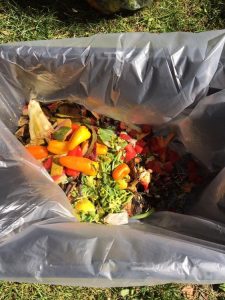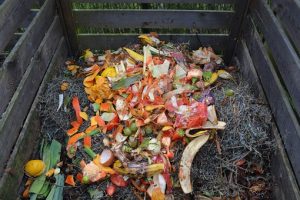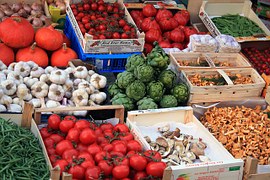It’s the holidays, and I’m sure you’ve already had a variety of requests from charities and non-profits asking you to help families in need this season. For some of us, food insecurity can seem non-existent because it is not our personal everyday experience and is often not visible. For others, it is an experience (even after overcome) that is a part of our everyday thoughts.
 Food insecurity is a complex problem that is both difficult to understand and difficult to solve. The underlying causes of food insecurity include things such as poverty, unemployment or underemployment, access to healthy food, etc., all of which are often deeply interconnected.
Food insecurity is a complex problem that is both difficult to understand and difficult to solve. The underlying causes of food insecurity include things such as poverty, unemployment or underemployment, access to healthy food, etc., all of which are often deeply interconnected.
For over 20 years, the USDA Economic Research Service (ERS) has put out an annual report for the state of food security in the U.S. These reports are a great resource for helping begin to understand the magnitude and complexity of food insecurity. The 2017 report is forty-four pages in length and provides a deeper dive into one of our country’s most challenging issues. It may or may not shock you that over 15 million households (11.8%) in the U.S. were classified as food insecure, meaning they had difficulty at some time during the year providing enough food for all their members due to a lack of resources. While the number of food insecure households has declined since 2011, this number is above the pre-recession (2007) level of 11.1%; we should not gloss over this fact. Further, 5.8 million households (4.5%) were classified as having very low food security, meaning the food intake of some household members was reduced and normal eating patterns were disrupted at times during the year due to limited resources.
As a bit of a self-admitted data nerd, I love statistics. However, I recognize how quantitative data can remove or mask the human element or experience of a phenomenon. While all of the numbers listed above are powerful and help us understand the magnitude of food insecurity, they can fail to remind us that food insecurity is also a lived experience. In the 2017 report, the USDA ERS conducted a qualitative survey of households classified as having low food security, which represented 5.8 million households nationwide. From their survey, the following experiences were reported:
- 99% reported having worried that their food would run out before they got money to buy more.
- 97% reported that the food they bought just did not last and they did not have money to get more.
- 95% reported that they could not afford to eat balanced meals.
- 96% reported that an adult had cut the size of meals or skipped meals because there was not enough money for food; 88% reported that this had occurred in 3 or more months.
- 93% reported that they had eaten less than they felt they should because there was not enough money for food.
- 68% reported that they had been hungry but did not eat because they could not afford enough food.
- 48% reported having lost weight because they did not have enough money for food.
- 30% reported that an adult did not eat for a whole day because there was not enough money for food; 24% reported that this had occurred in 3 or more months.
You might be thinking, what does this mean for our families in Ohio? When looking at the average prevalence of household food insecurity from 2015-2017, Ohio ranks 13th for the highest food insecurity with 13.7% of households classified as food insecure; that’s approximately 640,000 households. To give you some context, New Mexico is ranked number one with 17.9% of their population classified as food insecure and Hawaii is ranked 51st with 7.4% of their population classified as food insecure. In terms of very low food security, Ohio ranks 11th with 6.1% of our population (285,000 households) in the more severe range where meals are often skipped. Again for context, Louisiana ranks number one with 7.1% of their population having very low food security and Hawaii is again ranked 51st. While it may be difficult to admit, Ohio is not faring so well.
 A deeper dive into food insecurity can be overwhelming for many. The data can be daunting and the complexity of the issue can leave us feeling helpless. But remember that small acts of kindness can have meaningful community impacts. As someone who gets to see the impact of grassroots level food security work every day in my job, I encourage you to engage in a service project in your community this season to help feed families in need. Whether you donate items, money, or more importantly, your time, you can help join the fight against hunger.
A deeper dive into food insecurity can be overwhelming for many. The data can be daunting and the complexity of the issue can leave us feeling helpless. But remember that small acts of kindness can have meaningful community impacts. As someone who gets to see the impact of grassroots level food security work every day in my job, I encourage you to engage in a service project in your community this season to help feed families in need. Whether you donate items, money, or more importantly, your time, you can help join the fight against hunger.
 What will you do to help fight hunger in your community? To learn more about food insecurity contact Amanda Osborne, educator, community development (CD), OSU Extension-Cuyahoga County.
What will you do to help fight hunger in your community? To learn more about food insecurity contact Amanda Osborne, educator, community development (CD), OSU Extension-Cuyahoga County.
The content of this site is published by the site owner(s) and is not a statement of advice, opinion, or information pertaining to The Ohio State University. Neither text, nor links to other websites, is reviewed or endorsed by The Ohio State University.
 The Produce Perks program was piloted in Cuyahoga County in 2010 by the Cleveland-Cuyahoga County Food Policy Coalition and is implemented locally by OSU Extension. Produce Perks is now Ohio’s statewide nutrition incentive program, guided by the Ohio Nutrition Incentive Network (OH-NIN).
The Produce Perks program was piloted in Cuyahoga County in 2010 by the Cleveland-Cuyahoga County Food Policy Coalition and is implemented locally by OSU Extension. Produce Perks is now Ohio’s statewide nutrition incentive program, guided by the Ohio Nutrition Incentive Network (OH-NIN). The formation of this network has provided many perks (pun intended)! One perk has been increased support for local and statewide marketing through new or expanded partnerships with agencies such as Ohio Department of Jobs and Families Services. In addition, with Support from Wholesome Wave and Ohio Department of Health, Produce Perks Midwest has been able to test innovative marketing tactics to help guide outreach efforts. Scaling up has also provided the benefit of increased funding; most notably, OH-NIN was awarded funding from Ohio Department of Health funding to implement Produce Perks across the state in 2018. To learn more about the statewide program impacts in 2017, click
The formation of this network has provided many perks (pun intended)! One perk has been increased support for local and statewide marketing through new or expanded partnerships with agencies such as Ohio Department of Jobs and Families Services. In addition, with Support from Wholesome Wave and Ohio Department of Health, Produce Perks Midwest has been able to test innovative marketing tactics to help guide outreach efforts. Scaling up has also provided the benefit of increased funding; most notably, OH-NIN was awarded funding from Ohio Department of Health funding to implement Produce Perks across the state in 2018. To learn more about the statewide program impacts in 2017, click  The partners spent 4 weeks at the farmers’ market doing outreach and promotion before beginning 8 weeks of scrap collection. The pilot offered free sunflower planting for children (and adults!) with compost from Rust Belt Riders to help spark community engagement and begin dialogue about food waste in the county.
The partners spent 4 weeks at the farmers’ market doing outreach and promotion before beginning 8 weeks of scrap collection. The pilot offered free sunflower planting for children (and adults!) with compost from Rust Belt Riders to help spark community engagement and begin dialogue about food waste in the county. As with any pilot project, you set out not really knowing what will happen and inevitably encounter a variety of challenges and valuable lessons. We were pleasantly surprised by the level of community engagement and support, but we did not consider any potential drawbacks such as odors. We quickly learned that we needed to ask program participants to place their containers in the fridge or freezer to slow decomposition and eliminate any unpleasant smells. A few very ripe containers caused some of our market neighbors to be a bit upset.
As with any pilot project, you set out not really knowing what will happen and inevitably encounter a variety of challenges and valuable lessons. We were pleasantly surprised by the level of community engagement and support, but we did not consider any potential drawbacks such as odors. We quickly learned that we needed to ask program participants to place their containers in the fridge or freezer to slow decomposition and eliminate any unpleasant smells. A few very ripe containers caused some of our market neighbors to be a bit upset. What can we do? A compost pile is an option if you own your home and have a small space available in your yard. Backyard composting is common in United States, but is best suited for those who own a home with a yard. The renter and apartment dwellers without a yard face the greatest challenge. According to the
What can we do? A compost pile is an option if you own your home and have a small space available in your yard. Backyard composting is common in United States, but is best suited for those who own a home with a yard. The renter and apartment dwellers without a yard face the greatest challenge. According to the 
 The economic effects of food waste are just as startling. Americans throw away the equivalent of $165 billion worth of food each year. In addition to food waste occurring at the consumer level, 10% of the total food supply at the retail level enters the solid waste stream. The USDA estimates that supermarkets lose $15 billion annually in unsold fruits and vegetables alone, in addition to the baked goods, meat, seafood, and ready-made foods that go unsold. These items can easily be recovered from the waste stream by donating them to local food banks and food pantries, and retailers can receive tax benefits for doing so.
The economic effects of food waste are just as startling. Americans throw away the equivalent of $165 billion worth of food each year. In addition to food waste occurring at the consumer level, 10% of the total food supply at the retail level enters the solid waste stream. The USDA estimates that supermarkets lose $15 billion annually in unsold fruits and vegetables alone, in addition to the baked goods, meat, seafood, and ready-made foods that go unsold. These items can easily be recovered from the waste stream by donating them to local food banks and food pantries, and retailers can receive tax benefits for doing so.
 How do you double consumer purchasing power at your local farmers’ market? Follow the lead of markets in Cleveland, Columbus, and Cincinnati. They have helped SNAP recipients with a free dollar-for-dollar match for every dollar spent (up to $10) using an Ohio Direction Card. In Cuyahoga County, the SNAP incentive program is referred to as Produce Perks, and the additional match provided can be redeemed for fresh fruits and vegetables.
How do you double consumer purchasing power at your local farmers’ market? Follow the lead of markets in Cleveland, Columbus, and Cincinnati. They have helped SNAP recipients with a free dollar-for-dollar match for every dollar spent (up to $10) using an Ohio Direction Card. In Cuyahoga County, the SNAP incentive program is referred to as Produce Perks, and the additional match provided can be redeemed for fresh fruits and vegetables.